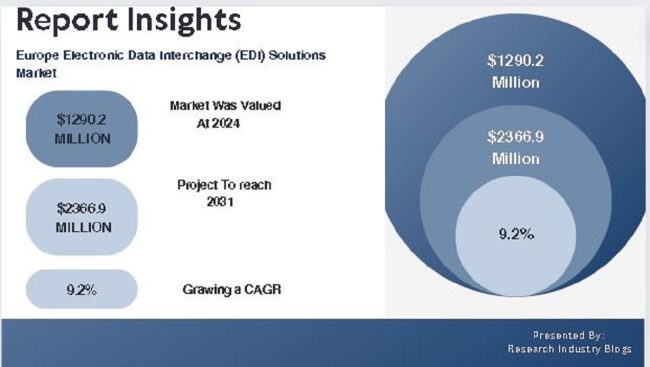In today’s hyper-connected world, seamless and efficient communication is paramount for businesses of all sizes. This is especially true when it comes to supply chains, where smooth information flow between trading partners is critical for success. Enter Electronic Data Interchange (EDI), a technology that has been steadily transforming business communication for decades and continues to evolve in the digital age.
Get Free Sample: https://www.metastatinsight.com/request-sample/2762
What is EDI?
EDI refers to the standardized electronic exchange of business documents between companies. Imagine replacing paper-based purchase orders, invoices, and shipping notifications with secure, digital transmissions. This is the essence of EDI. Standardized formats ensure that information is exchanged accurately and efficiently, eliminating manual data entry errors and streamlining communication.
Europe Electronic Data Interchange (EDI) Solutions Market Report Highlights
| Aspects | Details |
| Market Size By 2032 | USD 2366.9 billion |
| Growth Rate | CAGR of 9.2% |
| Forecast period | 2024 – 2032 |
| By Size | Large Enterprises SMEs |
| By Product | Electronic Data Interchange (EDI) VAN Web Electronic Data Interchange (EDI) Electronic Data Interchange (EDI) Outsourcing Electronic Data Interchange (EDI) Software Direct Electronic Data Interchange (EDI) Others |
| By Deployment | Cloud Based On-Premise |
| By End-User | BFSI Retail and Consumer Goods Healthcare IT and Telecommunication Transportation and Logistics Others |
| By Distribution Channel | Online Offline |
| By Region | North America (U.S., Canada, Mexico) Europe (Germany, UK, France, Italy, Spain, Rest of Europe) Asia-Pacific (China, Japan, India, South Korea, Indonesia, Rest of Asia-Pacific) LAMEA (Brazil, UAE, Saudi Arabia, South Africa, Rest of LAMEA) |
A Market on the Rise
The EDI market is experiencing significant growth, driven by several key factors:
- Rising Demand for Efficiency: Businesses are constantly seeking ways to optimize their operations and reduce costs. EDI automates communication, minimizes errors, and accelerates processes, leading to significant efficiency gains.
- Growth of E-commerce: The explosion of e-commerce has fueled the need for seamless data exchange between retailers and suppliers. EDI facilitates smooth order fulfillment and inventory management in this dynamic environment.
- Globalization: As businesses expand their reach across borders, they require reliable and secure communication with international partners. EDI provides a standardized framework for global information exchange.
- Technological Advancements: The emergence of cloud-based EDI solutions, Application Programming Interfaces (APIs), and the Internet of Things (IoT) is further propelling the market forward. These technologies offer greater accessibility, scalability, and integration with existing business systems.
Market Size and Projections
Industry analysts estimate the global EDI market to reach a staggering value of USD 64.79 billion by 2031, exhibiting a Compound Annual Growth Rate (CAGR) of close to 10%. This growth trajectory signifies the increasing importance of EDI in today’s business landscape.
Regional Landscape
While EDI adoption is widespread globally, certain regions are leading the charge:
- North America: Currently holds the dominant share in the EDI market, primarily due to the presence of well-established EDI infrastructure and a strong focus on supply chain efficiency.
- Europe: The European market is expected to witness significant growth in the coming years, driven by factors like increasing e-commerce penetration and growing regulatory requirements for data security.
- Asia Pacific: This region is projected to be the fastest-growing EDI market, fueled by rapid economic development and government initiatives promoting digitalization.
Key Market Segments
The EDI market can be segmented based on various factors, including:
- Deployment Model: On-premise, cloud-based, and hybrid solutions.
- Organization Size: Large enterprises and Small and Medium-sized Enterprises (SMEs).
- Industry Vertical: Retail, manufacturing, healthcare, logistics, and others.

Competitive Landscape
The EDI market includes a mix of established players and emerging companies offering a diverse range of solutions. Some of the key players include:
- IBM
- SAP
- Oracle
- TrueCommerce
- DiCentral
- OpenText
Emerging Trends
The EDI market is constantly evolving, with several key trends shaping its future:
- Cloud-based Solutions: Cloud-based EDI solutions are gaining traction due to their ease of deployment, scalability, and lower upfront costs. This trend is expected to continue, making EDI more accessible to SMEs.
- API Integration: APIs are enabling seamless integration of EDI with existing business systems like Enterprise Resource Planning (ERP) and Customer Relationship Management (CRM) software. This integration is fostering a more holistic view of business data and streamlined workflows.
- Blockchain Technology: Blockchain holds potential for revolutionizing EDI by enhancing security, traceability, and trust in data exchange. While still in its early stages of adoption, blockchain technology could transform EDI in the future.

Challenges and Opportunities
Despite its growth potential, the EDI market faces certain challenges:
- Complexity: Setting up and maintaining EDI systems can be complex, especially for smaller businesses. Standardization across industries can alleviate this issue.
- Security Concerns: Data security is paramount in EDI communication. Robust security protocols and compliance with data privacy regulations are essential.
- Cost Considerations: While cloud-based solutions are reducing costs, EDI implementation requires an initial investment.
However, these challenges are countered by significant opportunities:
- Growth of New Business Models: The rise of e-commerce marketplaces and on-demand services creates new opportunities for EDI adoption.
- Focus on Regulatory Compliance: Stringent regulations regarding data privacy and security can drive the demand for secure and compliant EDI solutions.
- Integration with Emerging Technologies: The integration of EDI with technologies like AI.
Contact Us:
info@researchindustryblogs.com
COMMENTS